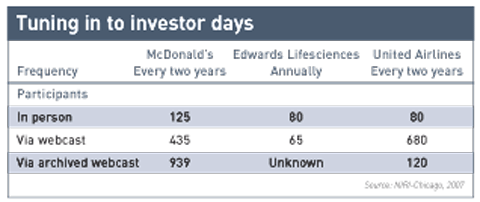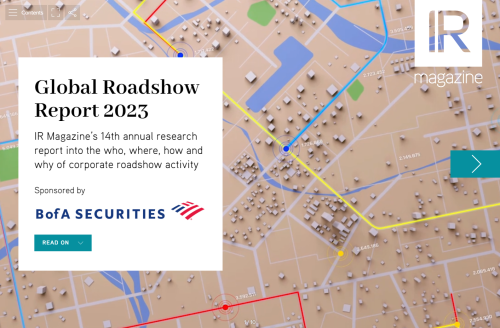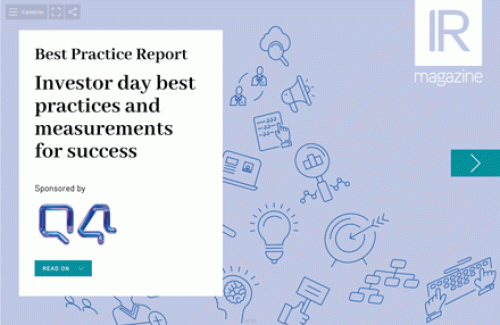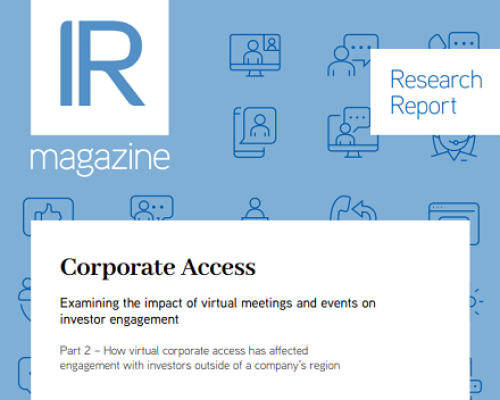- Strong interest in broadcasting analyst days
- Web conferencing extends reach and life of the event
- Graphics and video help keep viewers’ attention
A company-hosted analyst day is a key event on IR calendars. In contrast to the brief public platforms at roadshows or bank-sponsored conferences, analyst days offer the space for a firm to shape and develop its story over the timeframe it needs.
Whether over two hours or two days, companies are taking that time to show off the executive team and articulate their financial prospects and future direction. Investors clamor for them, as they are the primary way to get a close view of management.
Lots of work goes into an event. IROs begin locking in management calendars up to a year in advance, and then work out the agenda, coach the presenters and compile supporting materials eight to 12 weeks before the date.
While attending an analyst day in person may be the ideal, there is an audience for the information beyond the covering sell-side analysts. On a recent NIRI-Chicago panel, McDonald’s and United Airlines reported that those who log in to their analyst days via live web conferencing and archived webcasts outnumber actual attendees tenfold. Other interested parties include debt holders, rating agencies, regulators, institutional shareholders and financial media.
Broadcasting the analyst day means extending not only its reach, but also its life, as it helps create an archival record, so IR teams are looking to conferencing firms for help in connecting with this secondary audience. ‘We have seen increased interest in the company and its products from reaching a larger audience with more effective tools,’ says James Powers, president and CEO of iLinc. ‘Prospective investors, for example, may remain at their desks but still get a detailed glimpse into a firm’s management team and business prospects.’
Analysts themselves put a high priority on spending for travel to company-hosted events, and so far haven’t signaled they will cut back in the market downturn, says Conor Larkin, a senior associate in the perception group of Thomson Reuters. ‘But as travel is becoming an issue, webcasts are becoming more attractive,’ he adds.
Microsoft is a good example of a company making the most of its financial analyst day on the web. The event ran live with a high-quality video feed, but viewers can still tune in to the replay on the company’s IR website, and see presenters’ PowerPoint presentations and transcripts of their remarks.
This year, Colleen Healy, Microsoft’s general manager of IR, started the seven-hour event. CEO Steve Ballmer segued in with a 40-minute presentation on how the firm has performed and where it is going. The CFO, CTO, COO, division presidents and vice presidents also spoke for 20 minutes each and there were two panels featuring ‘executive discussion’.
Picture perfect
A video element like Microsoft’s isn’t necessary, although it is a trend descending on the IR community. ‘It is novel in some ways,’ says Larkin. ‘But investors want face-to-face interaction, and video may engage them better.’
ASOS, a small-cap UK online fashion retailer, is now using video for many IR events. ‘It is now a lot cheaper than before, hence you see companies listed on London’s Alternative Investment Market doing the live video webcasting that FTSE 250 firms do,’ says James Matthews, business development manager of Groovy Gecko, a conferencing provider. ‘Whether it is BP or ASOS, it’s the same template.’
Given their total length, IR events on the web need breaking up. From a webcaster’s point of view it is no problem, says Tracy Jones, director of product management at PrecisionIR Group, but attendees can get tired. ‘We suggest companies set up their event using a timed agenda and post that agenda on the webcast sign-in page so attendees can decide which presentations they want to attend,’ she says.
Powers notes that companies have many ways to keep listeners’ attention. ‘In addition to breaking the sessions up, we find hosts often mix in interactive tools like Q&A sessions and even breakout groups,’ he says. ‘This format mirrors the investor conference where the company presents and then moves to individual meeting rooms for personal interaction.’
Martha DeGraw, senior director of global product management at InterCall, agrees that audience inclusion is essential. ‘The biggest complaint about webcasts is that they are not interactive enough,’ she says. ‘We can facilitate that by taking questions live or via email.’
Replay on demand is another potential IR tool. ‘We see companies using the recording feature to extend their meetings and hold interest,’ says Powers. ‘They can then see who viewed the recording, and how often, to gauge interest and react accordingly. Event recording and post-event watching are increasingly important features, and one should not consider holding an event without those facilities.’
Long-playing records
Finally, companies are keeping webcasts in the public archives. Microsoft, for example, has both its 2007 and 2008 financial analyst days posted to its IR website. It does cost money to maintain them online, so some firms may not want them up in perpetuity.
‘We recommend a year, or until it is replaced by another one,’ Larkin says. ‘One of the biggest complaints from investors is that archived material is not available for long enough. You don’t want dated information up, but it holds value for research purposes.’
Many firms still use only audio webcasts, although they are often accompanied by slide presentations. Other options for dressing up an audio version include adding prerecorded video. ‘There may be a replay of a video prepared in advance, such as a message from the CEO,’ DeGraw says.
Still, the future points toward more video. ‘Most IR decisions are based upon ‘management cues’, and humans use visual cues to communicate, so video is essential,’ says Powers. ‘Combining graphics and video into a presentation provides not only those human interactions but also a variety of visual cues to keep the presentation flowing.’
Conferencing sound bites
‘Almost all companies issue press releases and send emails to institutional investors, so firms need to be creative in additional PR for their events. We do several extra things to drive investors to webcasts, such as hosting a proprietary event site, www.investorcalendar.com. We have 550,000 investors signed up for email alerts.’
Tracy Jones, Director of product management, PrecisionIR Group
‘Hectic work schedules mean watching an archived event or a podcast offers clients the flexibility of viewing the webcast at their leisure. This has become so popular that many clients are recording their sessions via conference call, providing content such as the MP3 file and PowerPoint presentation, and asking us to build the event and provide the URL. In this instance, there is no live event, only an archive.’
Jeff Jacksic, Senior manager for dedicated accounts, Bell Conferencing
‘We offer a ‘participation meter’ whereby hosts can see how engaged attendees are in the content, down to the individual, which is helpful for keeping content moving and soliciting feedback.’
James Powers, President and CEO, iLinc
‘You can have a function that searches webcasts for key words. Value-line investors or investment banks that are required to scour the presentations want that.’
Martha DeGraw, Senior director of global product management, InterCall










